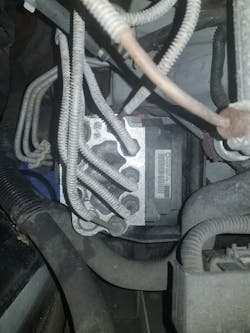In today’s world of automotive repair we’re faced with dealing with a broad range of different types of systems in modern day vehicles that reach our service bays.
Many of those systems have been there for many years but have evolved into a much more complex and highly sophisticated part of your routine repair practices. A number of your so-called routine diagnostic repairs have changed considerably over the years. Anti-lock braking systems (ABS) have been featured in vehicles for more than 50 years. They were, in fact, used in the aviation industry in the early 1950s.
The braking system on an automobile is perhaps the most important system on the vehicle when it comes to safety. Let’s face it, its job is to stop a 4,000 pound mass of metal and plastic in a reasonable amount of time and to prevent any bodily harm to its occupants and bystanders in the vicinity.
With the components used in the early systems like brake drums, brake shoes, disc pads and rotors coupled to a series of hydraulic lines acting off of hydraulic pressure, which is then operated by the reflexes of the driver to apply these components in a timely manner, they worked very well for many years. Even in today’s vehicles, these same components are used to stop the vehicle. But with the advent of ABS, these components are getting help from an outside source. The biggest change is actually in the help that the ABS systems will contribute toward the aid that the driver of the vehicle will receive. Let’s take a look at some of these systems and learn how to service and diagnose the problems that they can present.
Today’s ABS
The anti-lock braking system (ABS) is the same as our conventional braking system but with some extra components added and a lot of electrical add-ons. Since the ABS has received an array of electrical parts, it’s only fitting that these systems need to be monitored and some decisions need to be made by other factors besides the human driver.
The component responsible is the control module or specifically the electronic brake control module (EBCM). See Figure 1. The EBCM is a module that will receive inputs from various parts of the braking system and with the inputs from the vehicle’s driver. It then analyses the inputs that it receives and makes a decision on hydraulic pressures that should be applied so the vehicle will stay in a safe position based on the current conditions it has received.
When the module receives the inputs necessary it then processes the information and generates the proper output. When the inputs to the control module are not sending the correct signals or no signals at all, that’s when servicing the ABS will present our greatest challenges as technicians.
Some of the inputs that the EBCM will need to make the correct decision are from the wheel speed sensors (WSS), see Figure 2, vehicle speed sensors, brake pedal position (BPP) sensor, steering angle sensor (SAS), yaw rate (YAW) sensor, and many other sensors plus the added electrical circuits, solenoids, control valves and connections.
It also looks at the hydraulic circuits as well. If the conventional brake hydraulic pressure isn’t correct the system will not operate properly.
The EBCM not only monitors the components in the braking system, but it also communicates with several other electrical systems on the vehicle. The ECM, TCM, SRS, BCM and other modules communicate on a bus network and share information with each other.
If the EBCM is generating incorrect information, the other modules on the network could possibly set DTCs of their own, indicating a problem with the ABS.
When working on an ABS, it is extremely important to have access to a capable scan tool (see Figure 3). Capable means it has to be able to access ABS data, be able to have the capabilities of bidirectional control, miscellaneous function tests, and more importantly, be updated to the current model year you are working on. ABS diagnostics using a scan tool is mission critical when looking at the data pids and without a doubt your scan tool should have graphing capabilities (see Figure 4).
The wheel speed sensors are probably the most important sensors from which the EBCM receives its information. When testing an ABS, set up your scan tool in graphing mode and road test the vehicle.
For safety reasons, set up your scan tool to record a movie. When you return back to the shop you can playback your recorded movie and look at all the WSS to see if they are reporting the correct data. There you can see if the sensors are telling the EBCM the truth.
If for some reason you find a glitch or a dropout in your scan data waveform you can look at that sensor in a little more detail for a problem. In the screen shot shown in Figure 5, you will see a dropout with this particular sensor. A dropout could be caused by an erratic signal generated by the sensor.
Some causes could involve a toner ring that has a problem with a missing tooth or it possibly got bent or knocked out of place and the sensor can’t pick it up. There could also be a problem with the internal part of the sensor or the wiring and or connection going to that sensor. Wheel speed sensors generate an AC signal which is converted back to a DC signal. If there is any type of interference in the signal from the sensor the EBCM will receive that as a problem and thus flag that particular circuit in the form of a DTC.
Most WSS are a permanent mount type but there are some that are mounted in a sleeve and can be adjusted to the correct position.
When testing an individual wheel speed sensor, a capable DVOM (digital volt ohm meter) or a lab scope is needed. A common test on a WSS is a resistance test and an AC voltage test. When performing a resistance test, the WSS connector needs to be disconnected and your DVOM set to the ohms scale. Measure across both terminals at the sensor. The spec for your sensor will vary but in your information system you will find the spec tolerances.
The AC signal test is the same hook up at the sensor that you did for the resistance test, but remember to change your DVOM scale to read AC volts. This is where a lab scope shines in that you can see this reading in a graph form.
When performing this test, spin the wheel by hand and note your reading. You should see a sine wave showing you the AC pulses that the sensor is putting out. Depending on the vehicle, where the sensor is mounted in relation to the toner wheel that it gets its reading from will determine how your sine wave looks. If you have a toner wheel out of position, you will see an erratic sine wave. If you have a weak WSS you will see a small sine wave.
Just a minor incorrect reading is enough to give the EBCM some bad information and quite possible set an ABS warning indicator light or trouble code. In some cases, the brake pedal will pulsate or kick back on your foot while depressing the pedal and not activate a trouble code but makes the driver aware that something is amiss. When that happens as it did on a Chevrolet Express van that I was asked to look at, the WSS had a very slight dropout that the EBCM would catch. This happened to be caused by a front wheel bearing that had an excessive amount of play.
The bearing was moving so much that the WSS sensor didn’t have a direct reading on the ABS toner ring that was mounted on the inside of the brake rotor. For an ABS to work properly, the front suspension of the vehicle should be checked prior to diagnosing the ABS system. A failed or worn out suspension component could cause an ABS problem but in fact the vehicle might not have a brake problem at all.
I mentioned earlier, the ABS works in conjunction with other systems on the vehicle. The Cadillac Escalade uses approximately 12 different control systems depending on the vehicle options it came with. Some of the systems used are traction control, stability control, hill decent control system, hill hold start assist, intelligent brake assist system, the trailer brake control system and a few more systems as well.
As you can see, the ABS has changed immensely over the last decade or so and that’s why you need to stay updated on your training and invest in the proper tools as well. This Cadillac Escalade uses two high speed serial data networks — the high speed GMLAN serial data 1 and high speed GMLAN serial data 2. These are the circuits that do the communicating for the EBCM with the other system modules (see Figure 6).
We don’t have the space to cover the communication circuits and how they work in this article, but the EBCM does play a big part in the overall communication protocol in modern vehicles of today as the braking system is one of the major safety items on a vehicle. As with any vehicle, if the electronic braking system fails, the old reliable hydraulic system takes over until the problem can be addressed at a service facility.
Let’s take a closer look at an ABS system on a 2012 Ford F-150 pickup truck. This truck has advance track with roll stability control (RSC). The advance track system is made up with the following systems: conventional ABS, traction control and electronic stability control (ESC). The RSC is an option and works in conjunction with the advance track and incorporates many different systems and components. The ABS module, the HCU or hydraulic control unit, the stability control sensors, steering wheel rotation sensor, hill decent control switch and other components. The first order of business when diagnosing this system is to perform a good visual inspection. Many issues can be caught by performing this step.
Next is a capable scan tool so you can access all modules on the vehicle (see Figure 7). When an ABS or traction control indicator light illuminates on the dash, don’t immediately go into that system. Perform an all-system scan because there could be problems in other systems that triggered the ABS light. In the “old” days, if an ABS light was on, it was probably isolated in just the anti-lock braking system. Today there could be multiple systems that could be the cause of the ABS malfunction. Nowadays, you have to think outside of the box.
The HCU or hydraulic control unit (see Figure 8) is probably the most expensive part on the ABS system. It houses the EBCM which in most cases is serviced separately and the control solenoids and/or valves that control the direction and pressure of the of the brake system.
The scan tool in most cases will be able to test this unit using the special test or bidirectional control feature (see Figure 9) to activate the solenoids for proper operation.
Another component is the brake booster sensor (see Figure 10). This sensor is used to signal the EBCM that a hill start assist is needed. Hill start assist helps the driver when accelerating from a stop on an incline or side of a hill. Hill start assist supports the driver during drive-off situations on upward gradients. When the driver releases the vehicle brake, hill start assist prevents the vehicle from rolling back in the opposite direction.
The hill start assist system engages automatically when the following conditions are met: the driver applies the vehicle brake and the vehicle is at a complete stop; road inclination of approximately 4 degrees or more is detected (as indicated by the stability control sensor information); the vehicle transmission information indicates that the driver selects the correct gear, indicating the intention to drive up the hill; the parking brake is not engaged.
Once all the above criteria have been met and the driver releases the brake pedal, hill start assist utilizes the valves in the HCU to hold the car stationary for up to 2 seconds, giving the driver time to accelerate the vehicle. As the vehicle accelerates, hill start assist gradually releases the brake pressure to make sure that the vehicle is neither rolling back nor driving off until there is sufficient driving torque to accelerate the vehicle forward.
Hill start assist also functions if the vehicle is facing downhill if the reverse gear is selected. This is just one of the systems that is taken into consideration by the ABS on this vehicle.
No matter what you are working on, it is extremely important that you understand the system and how it works. If you don’t understand how it works, how are you going to properly repair it?
New vehicle technology keeps changing, seemingly at the speed of light. Will you be able to keep up or will your ABS hold you back? ■
Edwin Hazzard owns South East Mobile Tech in Charleston, S.C., which is a mobile diagnostic and programming service providing technical service to many automotive and body repair shops. He has 35 years’ experience in the automotive industry. He currently is an automotive trainer, a board member of TST (Technician Service Training), a member of the MDG (Mobile Diagnostic Group), a member of the Professional Tool and Equipment advisory board for Pten magazine, a committee member of Nastaf, and is a beta tester for multiple tool makers.


